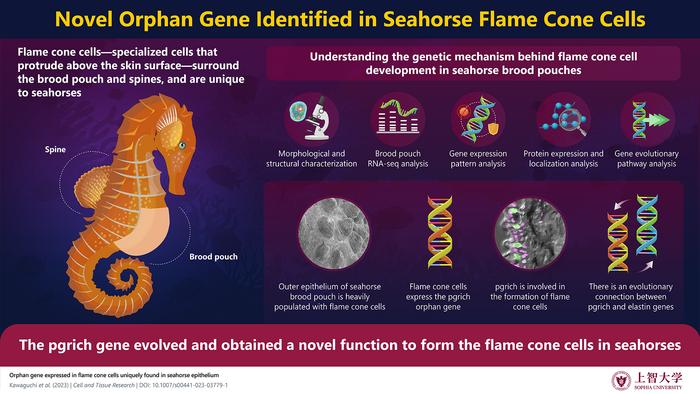Teleost fish encompass a diverse group, among which seahorses display a unique morphology. The characteristic spines and brood pouch seen in seahorses feature distinctive epithelial cells—called flame cone cells—covered by a mucous cap. However, these cells are not found in the barbed pipefish Urocampus nanus or the seaweed pipefish Syngnathus schlegeli, close relatives of the seahorse, belonging to the Syngnathidae lineage. While research has hypothesized the function of the flame cone cells, their evolutionary origins have remained a mystery.

Credit: Mari Kawaguchi from Sophia University
Teleost fish encompass a diverse group, among which seahorses display a unique morphology. The characteristic spines and brood pouch seen in seahorses feature distinctive epithelial cells—called flame cone cells—covered by a mucous cap. However, these cells are not found in the barbed pipefish Urocampus nanus or the seaweed pipefish Syngnathus schlegeli, close relatives of the seahorse, belonging to the Syngnathidae lineage. While research has hypothesized the function of the flame cone cells, their evolutionary origins have remained a mystery.
Now, a team of scientists led by Assoc. Prof. Mari Kawaguchi and Prof. Shigeki Yasumasu from the Department of Materials and Life Sciences at Sophia University have identified an ‘orphan’ gene—a gene with no identifiable homologous sequences in other species or lineages—in the seahorse Hippocampus abdominalis. They believe that this gene, called the proline-glycine rich (pgrich) gene, is linked to the development of the flame cone cells in the brood pouch. Their findings were published in the journal Cell and Tissue Research, on 25 May 2023.
Expanding the reason behind pursuing this investigation, Dr. Kawaguchi says, “Seahorses have fascinating morphology, and males carry embryos in their brood pouch. The occurrence of male seahorses giving birth is a rare phenomenon in the animal kingdom and makes the seahorse a model organism to study evolution. We were keen to identify the genes responsible for forming the flame cone cells in the brood pouch.”
The team first paired histological staining with electron microscopy to confirm that the flame cone cells were present on the outer epithelium of the brood pouch in H. abdominalis, but not in U. nanus or S. schlegeli. Next, in situ hybridization and immunohistochemical methods revealed that the pgrich gene was expressed and its protein was localized in flame cone cells of the body surface.
The amino acid sequences of protein product of pgrich gene, PGrich showed partial similarity with the translated amino acid sequence deduced from the antisense strand–the noncoding part–of greater pipefish elastin gene. Through sequence analyses, the team uncovered many transposable elements around the pgrich gene. They propose that the pgrich gene might have evolved from the elastin gene in pipefish and subsequently obtained a novel function in the formation of flame cone cells, which are unique to seahorses.
As the team continues to piece together the evolution of the seahorse brood pouch, Dr. Kawaguchi concludes, “The evolutionary history of the pgrich gene may provide clues as to how the orphan gene came to be and how the brood pouch developed in this lineage. Seahorses are popular in home aquariums, and understanding these phenomena will contribute to people’s fascination with these fish!”
Reference
【Title of original paper】Orphan gene expressed in flame cone cells uniquely found in seahorse epithelium
【Journal】Cell and Tissue Research
【DOI】10.1007/s00441-023-03779-1
【Authors】Mari Kawaguchi1, Wen‐Shan Chang1, Hazuki Tsuchiya1, Nana Kinoshita1, Akira Miyaji1, Ryouka Kawahara‐Miki2, Kenji Tomita3, Atsushi Sogabe4, Makiko Yorifuji5,6, Tomohiro Kono2,7, Toyoji Kaneko3, Shigeki Yasumasu1
【Affiliations】1Department of Materials and Life Sciences, Faculty of Science and Technology, Sophia University, Chiyoda‐ku, Tokyo, Japan, 2Genome Research Center, NODAI Research Institute, Tokyo University of Agriculture, Setagaya-Ku, Tokyo, Japan, 3Graduate School of Agricultural and Life Sciences, The University of Tokyo, Bunkyo‐ku, Tokyo, Japan, 4Department of Biology, Faculty of Agriculture and Life Science, Hirosaki University, Bunkyo, Hirosaki, Aomori, 036-8561, Japan, 5Sesoko Station, Tropical Biosphere Research Center, University of the Ryukyus, Sesoko, Motobu, Okinawa, 905-0227, Japan, 6Demonstration Laboratory, Marine Ecology Research Institute, Arahama, Kashiwazaki, Niigata, 945-0017, Japan, 7Department of Bioscience, Tokyo University of Agriculture, Setagaya-Ku, Tokyo, Japan
About Sophia University
Established as a private Jesuit affiliated university in 1913, Sophia University is one of the most prestigious universities located in the heart of Tokyo, Japan. Imparting education through 29 departments in 9 faculties and 25 majors in 10 graduate schools, Sophia hosts more than 13,000 students from around the world.
Conceived with the spirit of “For Others, With Others,” Sophia University truly values internationality and neighborliness, and believes in education and research that go beyond national, linguistic, and academic boundaries. Sophia emphasizes on the need for multidisciplinary and fusion research to find solutions for the most pressing global issues like climate change, poverty, conflict, and violence. Over the course of the last century, Sophia has made dedicated efforts to hone future-ready graduates who can contribute their talents and learnings for the benefit of others, and pave the way for a sustainable future while “Bringing the World Together.”
Website: https://www.sophia.ac.jp/eng/
About Associate Professor Mari Kawaguchi from Sophia University
Dr. Mari Kawaguchi is an Associate Professor in the Department of Materials and Life Sciences, Faculty of Science and Technology at Sophia University. Her area of interest is evolutionary biology, and she is studying the developmental and evolutionary processes of brood pouches in seahorses and pipefish. Dr. Kawaguchi has published over 40 peer-reviewed articles since 2003.
Funding information
Funding was in part through a Grant-in-Aid for Scientists (C) (19K06793 and 22K06344) to M. Kawaguchi and by a Cooperative Research Grant of the Genome Research for BioResource, NODAI Genome Research Center, Tokyo University of Agriculture to M. Kawaguchi, R. Kawahara-Mika, and T. Kono.
Journal
Cell and Tissue Research
DOI
10.1007/s00441-023-03779-1
Method of Research
Experimental study
Subject of Research
Animals
Article Title
Orphan gene expressed in flame cone cells uniquely found in seahorse epithelium
Article Publication Date
25-May-2023
COI Statement
Authors declare no competing interests.




